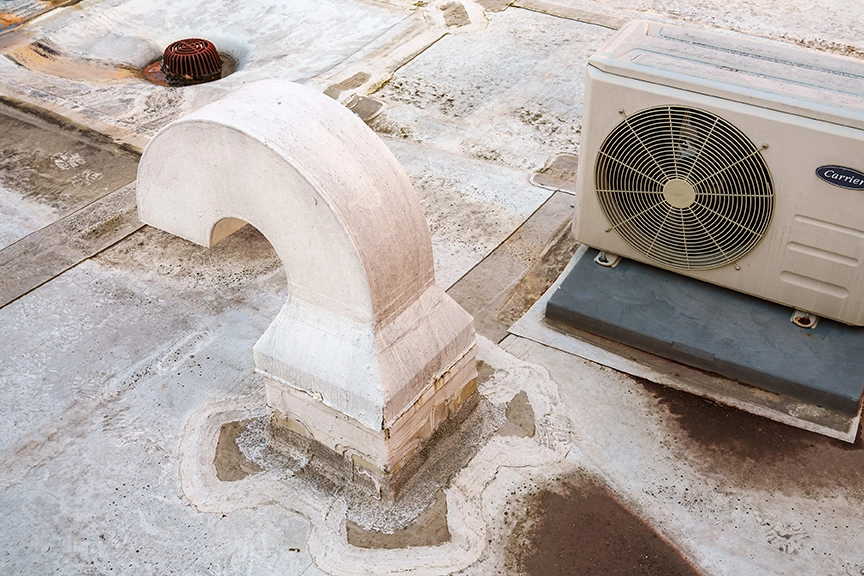What’s on your roof?
When it comes to a commercial roof, there can be a lot going on up on top. There are many different types of commercial building roof types. Unlike a residential roof that might only feature a chimney, skylight, or solar panels, commercial roofs could feature all of these things, in addition to pipes, vents, and Heating, Ventilation, and Air Conditioning (HVAC) blocks, which are just a few of the different types of roof penetrations.

A roof penetration refers to any opening or structure that passes through the surface of a roof in a factory or commercial building. These penetrations are typically created to accommodate various components or systems that require access to the interior of a building or to provide functionality to the building. Penetrations are most common on flat roofs, because these types of roofs often require pipe access, drainage, and ventilation. Almost every commercial roof will require some type of penetration for the building to function properly.
Roofing penetrations work effectively as long as a qualified, licensed roofing contractor performs the work of installing the apparatuses, and you have properly designed roof attachments. General contractors do not have the proper licenses or roofing skills to perform this type of work, so it’s critical you hire a roofing professional. Nobody wants to deal with an emergency roofing repair, nor do you want the object you are installing to be seriously damaged.
New Penetrations
In addition to engaging a qualified roofing professional, you also want to ensure the components that will be penetrating the roof are properly designed, so they can be installed using industry-standard best practices. Coordination between the installing contractor and roofing contractor, combined with properly designed roof attachments, will result in completely watertight roof penetrations that are virtually maintenance-free.
Existing Penetrations
With so many components entering a building, it’s not surprising that factories and commercial buildings with existing roof penetrations will often require more regular maintenance than roofs without these apparatuses. Even well-built roofing penetrations are vulnerable. As such, commercial roof inspections should be performed to ensure that the penetrations, flashing, sealants, and other elements of the breaches are monitored regularly to prevent a roof from leaking.
“Flashing” refers to protective materials, such as metal or rubber, which are used to seal the penetrations and prevent water infiltration around the openings and must be inspected regularly to prevent a potential leak from forming. Some older commercial roofs may also have pitch pans, which are metal boxes that surround the penetration and are filled with grout. Most commercial roofing companies no longer build new pitch pans, because they leak easily.
To prevent a problem before it starts, every commercial and factory building owner should be familiar with the most common types of roof penetrations and what should be done to ensure their roof remains intact.
Most Common Types of Commercial Roof Penetrations
Vents: Various types of vents, such as exhaust vents, intake vents, or ventilation pipes, are installed on commercial roofs to allow for proper air circulation and ventilation within the building.
HVAC Units: HVAC units are often placed on a roof to provide temperature control and climate regulation for the facility. These units require access to the building’s interior and are typically mounted on curbs or platforms.
Skylights: Skylights are windows installed on a roof that allow natural light into a building. They provide aesthetic appeal and can help reduce the need for artificial lighting during the day.
Chimneys and Flues: Commercial buildings that have fireplaces or utilize combustion systems may have chimneys or flues that penetrate the roof to safely vent out smoke and gases produced by the combustion process.
Pipes and Ducts: Plumbing pipes, electrical conduits, or HVAC ductwork may extend through a roof to connect various systems within the building to external sources or to facilitate the distribution of utilities.
Communication Equipment: Antennas, satellite dishes, or other communication equipment may be installed on a roof to facilitate wireless communication or data transmission.
Commercial Roof Maintenance
The best way to avoid roofing problems is to catch them early. If your roof has a high volume of penetrations, have it inspected every three to four months. Regular inspections and roof care maintenance of the penetrations and flashing is essential to identifying any signs of potential damage and deterioration or to determine if a roof leak repair is required. Avoiding roof maintenance is a good way to guarantee an emergency roof repair service will be necessary.
If there is a problem and a roof does need to be repaired, you should contact a qualified roofing professional who can handle the fix. Timely repairs can extend the life of your roof, saving money and giving you more time before a full roof replacement is necessary.
Selecting the Right Commercial Roofing Technician
Be sure to do your research when selecting a roofing technician. They should have undergone extensive training, be committed to producing quality work, and carry the proper licensing. The right roofing professional should also have specialized expertise in the numerous types of roofing systems that are available, in addition to knowing what repair materials to use for every type of roof substrate. This will ensure effective, lasting results.
If your commercial facility has flashings and penetrations, and you don’t have a commercial roof maintenance plan, contact us! We can set up a maintenance plan, perform a commercial roof inspection, and teach you how to protect your roof’s penetrations, in order to prevent an urgent roof repair from being needed.